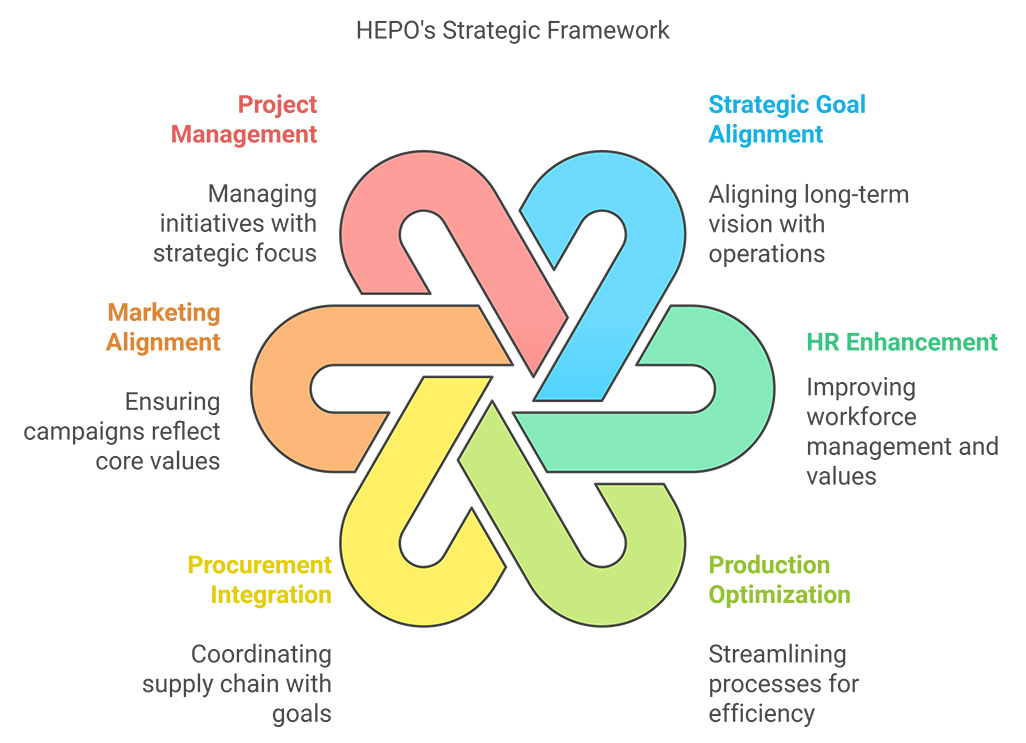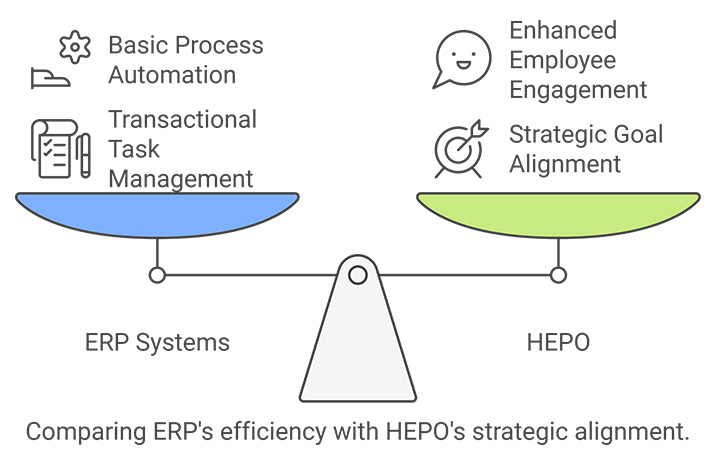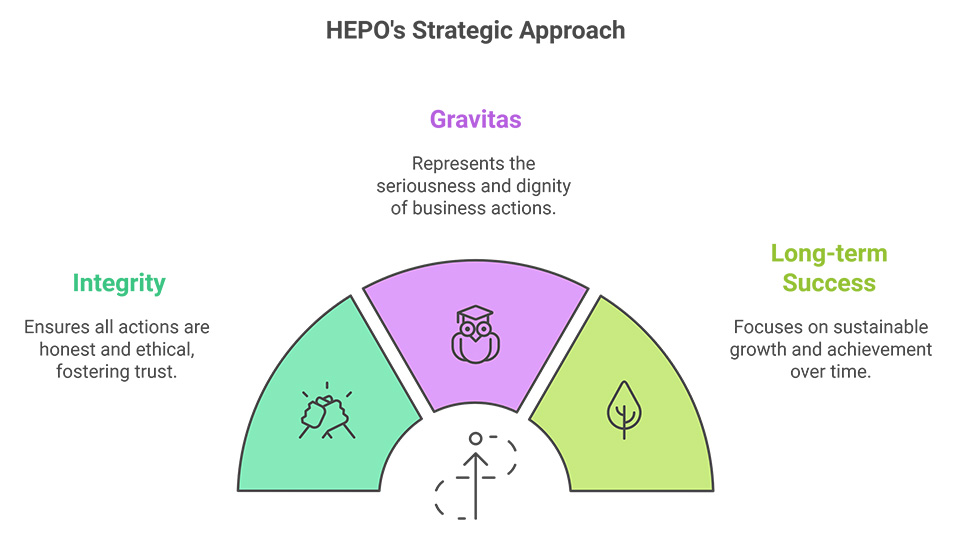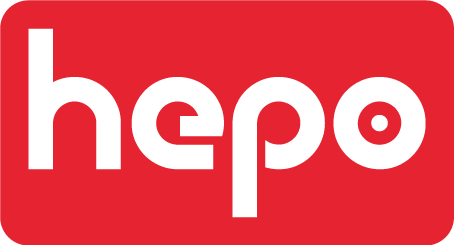COMPARISON WITH ERP
SYSTEMS

First and foremost, HEPO does not try to eliminate or replace ERP
systems. Instead HEPO either runs over ERP systems or runs aligned with them.
WHAT HEPO DOES
HEPO is designed to empower corporations by emphasizing the ultimate
goals and intangible values such as dignity, integrity, gravitas, and
reliability that guide every corporate action. Instead of narrowly focusing on
transactional data without broader context, HEPO offers a comprehensive,
high-level managerial approach. It seamlessly integrates strategic goal
alignment with day-to-day operations, enhancing areas such as HR, production,
procurement, marketing, project management, workload management, and reporting.
By connecting every effort to the company’s mission, HEPO ensures that business
activities not only meet targets but also uphold the company's core values and
long-term vision.
While traditional ERP systems focus on tracking and managing
transactional data—essentially capturing what’s already happened—HEPO adopts a
forward-thinking approach. By leveraging regression analysis and correlation
matrix HEPO not only plans and measures performance but also predicts and
drives future outcomes. This top-down method enables proactive management,
aligning strategies and goals seamlessly.
Human Resources (HR):

ERP: Manages transactional HR tasks like job postings, CV collections,
and evaluations.
HEPO: Aligns every hire with strategic goals, ensuring each employee
contributes to the company’s mission. Instead of only filling positions, HEPO
connects recruitment to long-term objectives and employee growth. HEPO analyzes
how aligned recruitment practices are with company goals and measures the
impact of strategic hires on overall performance and employee satisfaction.
With HEPO, seemingly basic and ordinary tasks become an important part
of people management. For example, HEPO, seamlessly running over existing ERPs,
offers unparalleled mobility designed for mobile use, enabling users to
interact with their teams anytime, anywhere. Employees can notify about changes
like sick leave effortlessly and track time and work progress natively,
eliminating the need for entrance cards, multiple notifications, and extensive
form-filling that traditional ERPs require. By streamlining processes, HEPO
enhances employee happiness, fosters career development, and helps retain
valued employees while eliminating inefficiencies. This alignment with the
company’s broad goals not only maintains but also elevates the gravitas and
dignity of both employees and the enterprise as a whole.
This approach ensures that every action is meaningful, contributing to
the company’s mission and values, and driving long-term success.
Procurement
ERP: Tracks orders and manages supplier relationships.
HEPO: Justifies each procurement decision based on business strategy,
cost-effectiveness, and sustainability goals. HEPO, Evaluates the alignment of
procurement actions with strategic goals and their impact on overall cost
savings and sustainability initiatives.
Asset Management
ERP: Tracks and manages physical assets.
HEPO: Aligns asset management with strategic objectives, ensuring assets
are acquired, maintained, and utilized efficiently. HEPO measures asset
utilization and maintenance efficiency against strategic objectives.
Warehouse Management
ERP: Manages inventory storage and logistics.
HEPO: Ensures warehouse practices align with broader strategic goals,
enhancing operational integrity. HEPO assesses how well warehouse management
supports strategic objectives and operational efficiency.
Marketing
ERP: Tracks marketing expenditures and results.
HEPO: Evaluates the strategic purpose of marketing efforts, integrating
customer data and market trends to maximize ROI and uphold company values. HEPO
analyzes the effectiveness of marketing campaigns in achieving strategic
objectives and enhancing brand reputation.
Sales
ERP: Tracks sales data and manages customer relationships.
HEPO: Aligns sales strategies
with company values, focusing on market trends and customer feedback to
maintain ethical conduct. HEPO evaluates sales performance against strategic
goals and customer satisfaction.
Customer Support
ERP: Manages customer
interactions.
HEPO: Integrates customer service with company values, enhancing the
company’s reputation for integrity and reliability. HEPO assesses the impact of
customer support on customer loyalty and brand reputation.
Project Management
ERP: Tracks project tasks and
milestones.
HEPO: Ensures projects align with strategic goals, evaluating their
contribution to corporate gravitas, integrity, and reliability. HEPO measures
project outcomes against strategic objectives and their impact on overall
company performance.
Training
ERP: Manages training programs.
HEPO: Aligns training with strategic goals, ensuring employee
development contributes to long-term objectives and values. HEPO analyzes the
effectiveness of training programs in achieving strategic goals and enhancing
employee skills.
Collaboration
ERP: Facilitates team interactions.
HEPO: Enhances team cohesion and performance by aligning collaborative
efforts with strategic objectives. HEPO evaluates the impact of collaboration
tools on team performance and strategic goal achievement.
Document and Content
Management
ERP: Manages document storage and retrieval.
HEPO: Ensures information accuracy and accessibility, aligning with
strategic goals and enhancing operational efficiency. HEPO assesses the
effectiveness of document management in supporting strategic objectives and
operational processes.

By comparing HEPO’s strategic approach with the transactional focus of
traditional ERPs and validating these assumptions through specific measures,
businesses can ensure that every action and decision drives towards their
ultimate goals of integrity, gravitas, and long-term success. HEPO’s
comprehensive approach ensures that every business process is not only
efficient but also strategically aligned, driving the organization towards its
goals.
